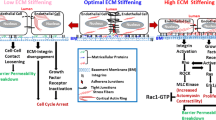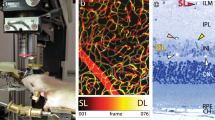Abstract
Vascular stiffness is an independent predictor of human vascular diseases and is linked to ischemia, diabetes, high blood pressure, hyperlipidemia, and/or aging. Blood vessel stiffening increases owing to changes in the microscale architecture and/or content of extracellular, cytoskeletal, and nuclear matrix proteins. These alterations, while best appreciated in large blood vessels, also gradually occur in the microvasculature and play an important role in the initiation and progression of numerous microangiopathies including diabetic retinopathy. Although macroscopic measurements of arterial stiffness by pulse wave velocity are often used for clinical diagnosis, stiffness changes of intact microvessels and their causative factors have not been characterized. Herein, we describe the use of atomic force microscopy (AFM) to determine stiffness of mouse retinal capillaries and assess its regulation by the cellular communication network (CCN) 1, a stiffness-sensitive gene-encoded matricellular protein. AFM yields reproducible measurements of retinal capillary stiffness in lightly fixed freshly isolated retinal flat mounts. AFM measurements also show significant changes in compliance properties of the retinal microvasculature of mice with endothelial-specific deletion of CCN1, indicating that CCN1 expression, or lack thereof, affects the mechanical properties of microvascular cells in vivo. Thus, AFM has the force sensitivity and the spatial resolution necessary to measure the local modulus of retinal capillaries in situ and eventually to investigate microvascular compliance heterogeneities as key components of disease pathogenesis.
Access this chapter
Tax calculation will be finalised at checkout
Purchases are for personal use only
Similar content being viewed by others
References
Lin J, Sorrells MG, Lam WA, Neeves KB (2021) Physical forces regulating hemostasis and thrombosis: vessels, cells, and molecules in illustrated review. Res Pract Thromb Haemost 5:e12548
Chaqour B (2020) Caught between a "Rho" and a hard place: are CCN1/CYR61 and CCN2/CTGF the arbiters of microvascular stiffness? J Cell Commun Signal 14:21–29
Moon S, Lee S, Caesar JA, Pruchenko S, Leask A, Knowles JA, Sinon J, Chaqour B (2020) A CTGF-YAP regulatory pathway is essential for angiogenesis and Barriergenesis in the retina. Iscience 23:2020.2003.2016.994293
Frye M, Taddei A, Dierkes C, Martinez-Corral I, Fielden M, Ortsater H, Kazenwadel J, Calado DP, Ostergaard P, Salminen M et al (2018) Matrix stiffness controls lymphatic vessel formation through regulation of a GATA2-dependent transcriptional program. Nat Commun 9:1511
Klein EA, Yin L, Kothapalli D, Castagnino P, Byfield FJ, Xu T, Levental I, Hawthorne E, Janmey PA, Assoian RK (2009) Cell-cycle control by physiological matrix elasticity and in vivo tissue stiffening. Curr Biol 19:1511–1518
Kniazeva E, Putnam AJ (2009) Endothelial cell traction and ECM density influence both capillary morphogenesis and maintenance in 3-D. Am J Physiol Cell Physiol 297:C179–C187
London GM, Marchais SJ, Guerin AP, Pannier B (2004) Arterial stiffness: pathophysiology and clinical impact. Clin Exp Hypertens 26:689–699
Palombo C, Kozakova M (2016) Arterial stiffness, atherosclerosis and cardiovascular risk: pathophysiologic mechanisms and emerging clinical indications. Vasc Pharmacol 77:1–7
Pessina AC (2007) Target organs of individuals with diabetes caught between arterial stiffness and damage to the microcirculation. J Hypertens Suppl 25:S13–S18
Cusma-Piccione M, Zito C, Khandheria BK, Pizzino F, Di Bella G, Antonini-Canterin F, Vriz O, Bello VA, Zimbalatti C, La Carrubba S et al (2014) How arterial stiffness may affect coronary blood flow: a challenging pathophysiological link. J Cardiovasc Med (Hagerstown) 15:797–802
Antonopoulos AS, Siasos G, Oikonomou E, Gouliopoulos N, Konsola T, Tsigkou V, Moschos M, Tentolouris N, Kassi E, Paschou SA et al (2021) Arterial stiffness and microvascular disease in type 2 diabetes. Eur J Clin Investig 51:e13380
Cardoso CR, Ferreira MT, Leite NC, Barros PN, Conte PH, Salles GF (2009) Microvascular degenerative complications are associated with increased aortic stiffness in type 2 diabetic patients. Atherosclerosis 205:472–476
Gordin D, Groop PH (2016) Aspects of Hyperglycemia contribution to arterial stiffness and cardiovascular complications in patients with type 1 diabetes. J Diabetes Sci Technol 10:1059–1064
Yannoutsos A, Levy BI, Safar ME, Slama G, Blacher J (2014) Pathophysiology of hypertension: interactions between macro and microvascular alterations through endothelial dysfunction. J Hypertens 32:216–224
Chaqour B (2013) New insights into the function of the Matricellular CCN1: an emerging target in proliferative retinopathies. J Ophthalmic Vis Res 8:77–82
Chaqour B (2013) Molecular control of vascular development by the matricellular proteins CCN1 (Cyr61) and CCN2 (CTGF). Trends Dev Biol 7:59–72
Chaqour B, Goppelt-Struebe M (2006) Mechanical regulation of the Cyr61/CCN1 and CTGF/CCN2 proteins. FEBS J 273:3639–3649
Hanna M, Liu H, Amir J, Sun Y, Morris SW, Siddiqui MA, Lau LF, Chaqour B (2009) Mechanical regulation of the proangiogenic factor CCN1/CYR61 gene requires the combined activities of MRTF-A and CREB-binding protein histone acetyltransferase. J Biol Chem 284:23125–23136
Reid SE, Kay EJ, Neilson LJ, Henze AT, Serneels J, McGhee EJ, Dhayade S, Nixon C, Mackey JB, Santi A et al (2017) Tumor matrix stiffness promotes metastatic cancer cell interaction with the endothelium. EMBO J 36:2373–2389
Eaton P, Batziou K (2019) Artifacts and practical issues in atomic force microscopy. Methods Mol Biol 1886:3–28
Rusaczonek M, Zapotoczny B, Szymonski M, Konior J (2019) Application of a layered model for determination of the elasticity of biological systems. Micron 124:102705
Chaqour B (2016) Regulating the regulators of angiogenesis by CCN1 and taking it up a Notch. J Cell Commun Signal 10:259–261
Chintala H, Krupska I, Yan L, Lau L, Grant M, Chaqour B (2015) The matricellular protein CCN1 controls retinal angiogenesis by targeting VEGF, Src homology 2 domain phosphatase-1 and Notch signaling. Development 142:2364–2374
Lee S, Ahad A, Luu M, Moon S, Caesar J, Cardoso WV, Grant MB, Chaqour B (2019) CCN1-yes-associated protein feedback loop regulates physiological and pathological angiogenesis. Mol Cell Biol 39:e00107
O'Connor S, Gaddis R, Anderson E, Camesano TA, Burnham NA (2015) A high throughput MATLAB program for automated force-curve processing using the AdG polymer model. J Microbiol Methods 109:31–38
Kim KH, Chen CC, Monzon RI, Lau LF (2013) Matricellular protein CCN1 promotes regression of liver fibrosis through induction of cellular senescence in hepatic Myofibroblasts. Mol Cell Biol 33:2078–2090
Moore BA, Roux MJ, Sebbag L, Cooper A, Edwards SG, Leonard BC, Imai DM, Griffey S, Bower L, Clary D et al (2018) A population study of common ocular abnormalities in C57BL/6N rd8 mice. Invest Ophthalmol Vis Sci 59:2252–2261
Chang B (2013) Mouse models for studies of retinal degeneration and diseases. Methods Mol Biol 935:27–39
Acknowledgments
This work was performed, at least in part, at SUNY Downstate Medical Center (Brooklyn, NY). This work was supported in part by grants from the National Eye Institute of the National Institutes of Health, EY022091 (to B.C.) and EY12601(to MBG).
Author information
Authors and Affiliations
Corresponding author
Editor information
Editors and Affiliations
Rights and permissions
Copyright information
© 2023 The Author(s), under exclusive license to Springer Science+Business Media, LLC, part of Springer Nature
About this protocol
Cite this protocol
Chaqour, B., Grant, M.B., Lau, L.F., Wang, B., Urbanski, M.M., Melendez-Vasquez, C.V. (2023). Atomic Force Microscopy-Based Measurements of Retinal Microvessel Stiffness in Mice with Endothelial-Specific Deletion of CCN1. In: Takigawa, M. (eds) CCN Proteins. Methods in Molecular Biology, vol 2582. Humana, New York, NY. https://doi.org/10.1007/978-1-0716-2744-0_22
Download citation
DOI: https://doi.org/10.1007/978-1-0716-2744-0_22
Published:
Publisher Name: Humana, New York, NY
Print ISBN: 978-1-0716-2743-3
Online ISBN: 978-1-0716-2744-0
eBook Packages: Springer Protocols




